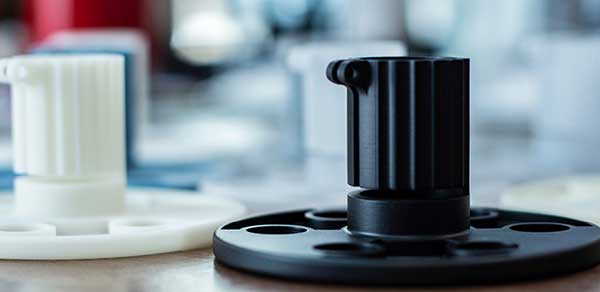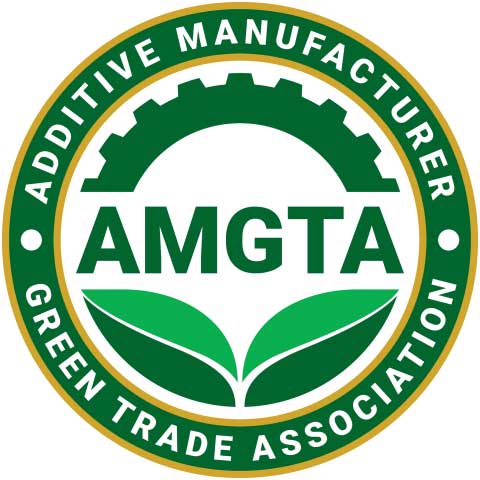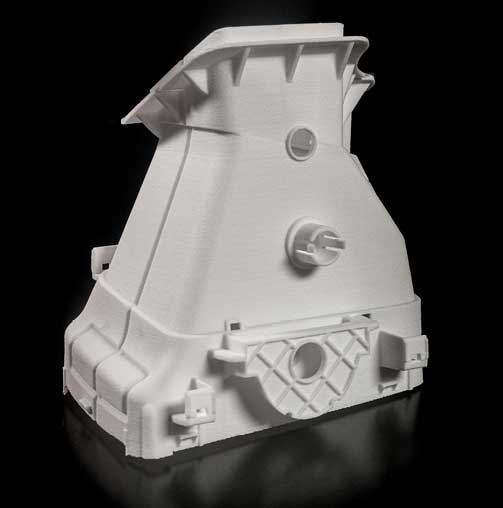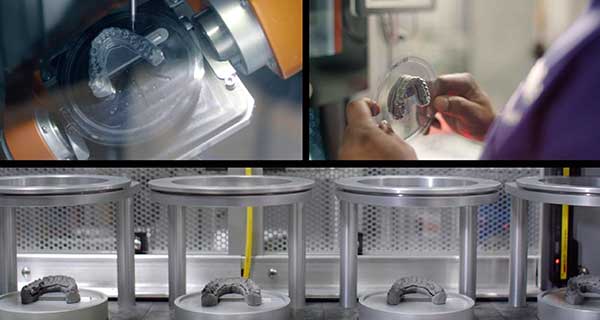Sustaining the Future of 3D Printing
Experts share their sustainability approaches for manufacturing the way to a more planet-friendly future.

An example of 3D printed stereolithography parts. Image courtesy of Xometry.
Latest News
February 26, 2021
3D printing has many merits, two of which are its ability to generate less waste in the final product compared to other manufacturing processes, and that it lends itself to functional design. Yet it’s not enough to rest on past environmental achievements if companies expect to remain successful green leaders well into the 21st century.
Manufacturers that anticipate not only surviving but thriving in the future are constantly seeking groundbreaking ways to “green” their processes. Under the sustainability umbrella, there’s a push toward more recyclable materials, green-certified best practices and an enhanced global supply chain to name a few. In what follows, experts across the industry share their recipes for a future filled with planet-friendlier processes.
State of the Industry

Manufacturing comprises up to one-fifth of emissions worldwide, according to Bryan Crutchfield, vice president and general manager, Materialise. “AM is often one of the first technologies that comes to mind when considering sustainable alternatives,” he says. Yet practices that companies implement don’t always qualify as truly sustainable.
The pandemic that consumed 2020 actually helped advance the sustainability conversation in additive manufacturing in taking sustainable suggested practices from good ideas to implementable actions.
“The COVID-19 crisis created momentum for additive manufacturing in 2020,” Crutchfield says. “3D printing stood out as a viable way to make a difference and provided an alternative way to produce vital goods and supplies in a fast, local, cost-efficient and safe way.
“Additive manufacturing can be a powerful tool for localizing and creating efficiencies in global supply chains to help improve manufacturing sustainability. By bypassing transportation requirements of a global supply chain, and in the small-batch manufacturing itself, companies can use local AM production to create less waste,” Crutchfield adds.

At HP, Lihua Zhao, head of 3D Printing Lab, HP Labs, says sustainability is here to stay as companies adapt to future challenges. “As we look into 2021, more manufacturers will turn to 3D printing for supply chain resiliency and to make scalability more viable, even for small businesses. All of this is in service of people—the creators, the workforces and, of course, the customers who benefit from a cleaner, more collaborative way of manufacturing.”
RIZE’s Andy Kalambi sees the sustainability discussion as a split between the environment and the economy. “The world is grappling with two aspects of sustainability—environment and socioeconomic. With sustainability, additive can enable organizations to reduce waste by reducing lot sizes, enabling personalization and improving material science. Emissions-free additive manufacturing with low-energy intensity processes can significantly reduce the carbon footprint of manufacturing.
“The COVID-19 crisis created momentum for additive manufacturing in 2020.”
On the economic front, Kalambi points to how additive manufacturing can “drive inclusive practices to enable creation of new supply chains, which empower micro-manufacturing. This can enable self-sufficient production, [and] drive employment and diversity for significant societal impact.”
Building Viable Manufacturing Strategies
Some experts suggest company leadership that endorses an open culture where all employees have a voice can lend itself to some worthwhile sustainability initiatives. In fact, the most effective sustainability strategies aren’t always born out of high-level, boardroom meetings. To Sherry Handel, executive director, Additive Manufacturer Green Trade Association, the employee with the winning sustainability strategy at your company can be anyone from the shipping clerk, engineer, on up to the CEO.


“Sustainability initiatives can come from any employee within the company sharing an idea on better ways to do things that [have less negative impact on] the environment,” she says. “The key to creating a sustainable culture within a company is for leadership to continually encourage employees to voice these ideas and suggest initiatives that will improve the environmental footprint of their operations.”
To transition from idea sharing to implementation, Handel suggests setting up a formal process where employees can offer ideas, ideas are carefully considered, ones that make the cut are implemented and then the entire workplace is involved in carrying them out.
“Companies that consistently evaluate and improve sustainability efforts on an ongoing basis generally achieve the most success,” Handel says.
When launching a sustainability initiative, companies need to analyze the entire lifecycle of prototyping and production, according to Derek Gary, Ethics & Compliance, at 3D Systems. “At the beginning of every manufacturing process, a company will start with sourcing and partnering with third-party vendors from around the globe. Every partner potentially represents a different local regulatory requirement and even a different culture that impacts how they conduct business. For 3D Systems, not only is the quality of the parts and materials important but how a partner produced that part is equally important,” Gary explains.
Over at RIZE, safety is near the top of the priority list when tackling future-forward sustainable practices. “As the pandemic has clearly shown, a major issue facing manufacturers and indeed all businesses today is the need for us to work flexibly and [be adaptive] in the current and future crisis. Being safe anywhere—home, school or office—will be key in staying productive,” Kalambi says.
“Moving to 2021 and beyond, a product’s digital information will be just as important as the product itself for continuity and building alternative suppliers.”
At HP, Zhao suggests that companies can adapt their sustainability strategy with “flexible infrastructure technologies” like 3D printing that allows for companies to localize and simplify supply chains.
“Since companies can transmit digital files globally at the tip of their fingers for production locally rather than shipping physical parts and products, 3D printing can lower the emissions related to distribution and warehousing,” Zhao says.
“In addition, 3D printing makes new breakthrough designs a reality, where the unique structure can add new performance properties with less weight, which cannot be produced with any other manufacturing technologies,” Zhao adds. “The result is reduced time to part and costs per part, decreased energy and resource consumption, and lower greenhouse gas emissions—all critical variables and priorities in promoting a circular economy.”
Aaron Pearson, vice president of public relations and analyst relations at Stratasys, adds that it’s important for today’s manufacturing companies to understand the complexities of the “carbon intensity of additive manufacturing compared to traditional manufacturing processes, as well as the carbon contributions from transporting products across complex supply chains.” Though he acknowledges some studies have shown how additive manufacturing can notably lower emissions, he notes, “there’s no question we need more extensive data. We should be able help our customers truly quantify it to help them make decisions about the full benefits of investing in additive manufacturing.”
Large Scale versus Localized Production
Simply relying on AM alone to increase sustainability efforts won’t work, acknowledges Materialise’s Crutchfield. He cites how BASF and Materialise recently conducted a Lifecycle Analysis (LCA) for the production of 1 million pairs of midsoles, assessing the environmental impact in all stages of the product cycle. The analysis concluded that for a large series of identical products, “3D printing is currently not the most sustainable choice and has a bigger impact on climate change and the depletion of fossil fuels compared to the conventional manufacturing technology when printing in a large scale.”


Though this analysis reviewed large series of identical products, Crutchfield says, “3D printing typically offers advantages for the production of smaller or customized series that can be produced locally. This helps to balance the environmental impact in favor of 3D printing. However, it remains crucial that the 3D printing industry continues to invest in technologies to make the 3D printing process more sustainable.”
Prepping for Incoming Challenges and Hurdles
To stay one chess move ahead of your competitors by anticipating disruptions such as supply chain lessons learned of 2020, Xometry’s Greg Paulsen, director of application engineering, says organization of your plans is critical.
“Companies need to keep organized technical data and requirements around their products, so if there is any disruption on critical goods (e.g., part models or drawings), they can quickly change roles from a buyer to a sourcing agent. During the first few months of the pandemic, with shutdowns across the globe, many manufacturers were willing to step up to the challenge, but the technical needs were often not fully defined. Moving to 2021 and beyond, a product’s digital information will be just as important as the product itself for continuity and building alternative suppliers,” he explains.
From HP’s viewpoint, the company realized the direct benefit of working together through the pandemic. “We saw this in the pandemic as companies like HP worked together with government agencies, healthcare providers, and academic and research institutes leaders around the world. We created a powerful ecosystem with a shared vision for saving lives and facilitating a more sustainable future—something that no single entity could have done alone.”
Companies that are ready to create a more sustainable product with the aid of 3D printing, but don’t know where to begin, should consider consultant services, according to Materialise’s Crutchfield. “Experienced AM consultants can help minimize the risk associated with investments and accelerate timelines by sharing their knowledge of the technology’s strengths and identifying the right manufacturing method needed for each unique case.”
Notable Tried-and-True Solutions
In 2020, Xometry in part focused on offsetting its carbon footprint for domestic shipping through collaboration with Dot Neutral. For instance, Xometry’s GoGreen initiative allows customers to offset their manufactured goods’ carbon footprint through an instant quoting opportunity. Customers can select methods of their choice, such as funding wind farms, solar arrays or forest conservation.
At Materialise, Crutchfield shares, in the past, when using only recycled material in AM, manufacturers would face a common issue known as the “orange peel effect,” where material does not cool properly between layers. This results in a rippled surface and a final product largely unusable for manufacturing. That leads to manufacturers using a mix of new and reused material, which is not sustainable.
Materialise’s Bluesint PA 12 offers a solution to the orange peel issue by using a two-laser process to keep the previous layer’s material above a specific temperature while the next layer is printed. This results in a printed object with similar mechanical and visual properties, but printed with 100% recycled powder. In 2021, Materialise aims to have several laser sintering machines running with Bluesint PA12.
“In the start-up phase alone, the company aims to re-use more than five tons of powder that would normally become waste,” Crutchfield says.
RIZE is “purpose-built for sustainability,” according to Kalambi. “Every aspect of our technology and user experience is designed for sustainable and green practices. This includes UL GREENGUARD certified printers and materials, which ensure an emissions-free environment, recyclable and non-toxic materials.” As recently as December 2020, RIZE achieved its fifth RIZE GREENGUARD certification, as a leading provider of GREENGUARD certified products in the 3D printing industry.
RIZE also is actively developing new business models that enable what the company refers to as “inclusive” additive manufacturing. “Our focus on Safe Anywhere Manufacturing of functional parts—both industrial and full-color consumer—makes us unique in the industry,” Kalambi notes.
“Every aspect of our technology and user experience is designed for sustainable and green practices.”
Over at 3D Systems, Gary cites the launch of their Environmental, Social & Governance (ESG) initiative in 2020.
“For us, it was important to formalize our commitment to taking action on global environmental, social, and health issues…,” he explains.
Some key activities that 3D Systems has implemented that directly target sustainability include: efforts within the company to reduce its carbon footprint (for example, in 2019, 3D Systems reduced its real estate assets by 10% resulting in lowering CO2 emissions by nearly 2.8 million pounds) and helping eliminate waste.
“The additive manufacturing solutions we provide have a positive impact on the environment by replacing, optimizing and creating processes that will help eliminate waste and reduce carbon emissions,” 3D Systems’ Gary explains.
AM can play a vital role in sustainability through optimized part designs. For example, Gary shares how an airplane component can now weigh less yet perform more efficiently, “resulting in lowered fuel costs and environmental impact.” Further, additive manufacturing only uses whatever material is needed to generate the final part, meaning less production waste than traditional methods.
At UL, a certifier of environmental product declarations and creator of product category rules programs, the company considers itself on a joint mission alongside customers and stakeholders to make the world safer, more secure and sustainable.

“We’re committed to reducing our worldwide energy and water usage, to finding new ways to recapture and reuse water and divert waste from our landfills, and to improving efficiency in our buildings and laboratories,” says Fred Arazan, senior business development manager, UL. Critical to achieving these goals, according to Arazan is its team of in-house expertise with dedicated task forces who set out to devise solutions. The company also supports and encourages advances of employee-led environmental pilots and initiatives.
“UL has many different ways to help clients achieve their sustainability goals through certification and validation programs based on meaningful metrics and science,” Arazan says.
Trends to Watch
Back at Xometry, their company has been integrating the need for distributive supply chains without the need for searching.
“Xometry has built a global supply chain that is accessed as if it was a single supplier,” Paulsen explains. “Supply chain consolidators help get the best of both worlds: by reducing the search effort needed by supply chain managers while ensuring that thousands of manufacturers have access to work even if their local customers are disrupted.”
In Materialise’s corner, experts there suggest that the growing use of customized and personalized 3D printing will lead to adaptation of sustainable practices into new industries. Additionally, the company points to increased demand for recycled materials in products being created.
HP has also boarded the personalization train, according to Zhao. “For many companies, mass personalization is the trend to watch,” Zhao notes, citing the example of SmileDirectClub, a company within the orthodontics industry. “Their all-digital model cuts the cost, shortens the time and makes it more convenient and cost effective for anyone to straighten their teeth. Our 3D printing technology allows them to produce millions upon millions of uniquely personalized mouth-molds for each of their customers at each of the stages of their journey to a better smile.”

Mass customization can’t be fully achieved with traditional manufacturing methods, Zhao explains. “But with 3D printing, every unique digital design can be printed facilely, and in a sustainable way; this level of personalization is now a reality.”
Kalambi at RIZE points to zero waste, low-energy intensity and low emissions as the top three focus areas where organizations that are “first-movers in sustainable production” are heading. “Readers should also look the new business models and changing consumer behaviors, which will make long-term secular shifts to such technologies,” he adds.
Stratasys’ Pearson suggests that additive will be less energy intensive than traditional manufacturing in many applications, and expects Stratasys to be providing more data on that. “We believe there are also opportunities to improve the sustainability and recyclability of 3D materials as well, such as through plant-derived materials. Sustainability is a priority initiative at Stratasys overall and we will be sharing more about our priorities as 2021 progresses.”
Lessons Learned
The supply chain took a hit this past year in unprecedented ways, leaving room for ample takeaway applications. “2020 was a wake-up call for many businesses in understanding how sensitive supply chains are, and most of us do not believe this is a one-off event. Business models like Xometry have demonstrated how distributed manufacturing services can help mitigate disruptions to keep both buyers and suppliers up and running,” Paulsen concludes.
Adds Crutchfield, “At Materialise, sustainability is not just a nice thing on our to-do list.”
Currently, Materialise’s 3D printing facilities use solar panels and recover heat from printers for its internal heating systems. In 2020, the company switched to 100% green electricity at Materialise HQ and aims to boost its own electricity production to 20% of total electric consumption by installing a solar field.
“[Sustainability is] necessary to achieving our mission of creating a better and healthier world,” Crutchfield adds. “As we move into a post-pandemic world, sustainability will be a major battle to keep our planet on track. It takes all industries, not just additive manufacturing, but others will hopefully be able to learn from our example.”
“Creating new sustainable production networks is an ecosystem play and needs active involvement and participation by multiple stakeholders—producers, supply chains, technologists and consumers,” Kalambi says. “Working on only parts of the solution lead to suboptimal and sometimes counterproductive results.”
More 3D Systems Coverage
More Hewlett Packard Coverage
More Materialise Coverage
More RIZE Coverage
Subscribe to our FREE magazine, FREE email newsletters or both!
Latest News
About the Author
Stephanie is the Associate Editor of Digital Engineering.
Follow DE





